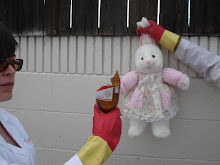 Purdy, ain’t she? So blue. And green. And yellow. And green and yellow in such organized bands across the globe. Start from the equator and look northward. Green, then yellow, then green again. Start from the equator and look southward. Green, then yellow, then green again. Why so organized? I'll tell you, homes, it's all about atmospheric circulation!
Purdy, ain’t she? So blue. And green. And yellow. And green and yellow in such organized bands across the globe. Start from the equator and look northward. Green, then yellow, then green again. Start from the equator and look southward. Green, then yellow, then green again. Why so organized? I'll tell you, homes, it's all about atmospheric circulation!
We live on a spherical planet and as such the most bulgy part of the world gets the most heat. Air at the equator is warmed up by solar energy and starts to rise. Convection takes over at this point and that warm air travels poleward while cooler air at the poles descends towards the equator. Simple enough, but not only is our planet spherical it rotates as well. The rotation of our planet sets in motion a very sneaky character that we now have to consider – the Coriolis effect.
Sorry to be a party pooper but no, your toilet is not affected by Coriolis. The system of fluid mechanics that is in your toilet is much too small to be influenced by the spinning of a gargantuan planet. What it does do is influence movement of stuff on the LARGE scale. I’m talkin’ ocean circulation, atmospheric circulation, intercontinental ballistic missiles, and the like.
As our warm air at the equator rises it looses the capability to hold moisture (see “Mommy, why does it rain?”). That’s why the tropics are so rainy. That air rises, dumps out all its moisture, then heads north or south. On its way it gets deflected by the Coriolis effect. The Coriolis effect deflects things to the right in the Northern Hemisphere and to the left in the Southern Hemisphere. You have to be careful with this deflection business because you’ve gotta think about it in the perspective of the air itself. Think of yourself moving along with the air. You’ll always veer right in the Northern Hemisphere and veer left in the Southern Hemisphere. A little hippy-dippy but the visualization helps in the long run.
At 30º N and 30º S the air hits a region of high pressure due to the “piling up” of more air that hasn’t moved its big butts outta the way on the journey towards the pole. The air starts to fall. It doesn’t have any moisture in it anymore so 30º N and 30º S get blasted with hot, dry air. This is why the world’s great deserts live at these latitudes. When the descending air gets lower in the atmosphere, some of it moves pole ward but some of it heads back towards the equator, creating the Trade Winds. The Trade Winds blow from East to West and in olden days came in handy for things like, yep you guessed it, trading! Hey, they were sailors, not wordsmiths. The air that keeps heading for the poles gets deflected from the West to the East, so we get the Westerlies between 30ºN and 60º N (and 30º S and 60º S). Around 60º N and 60º S our pole ward traveling air has been sufficiently warmed enough and rises again, giving us a bit of rain at these latitudes. We see on the figure above that the Horse Latitudes and Doldrums are spots you don’t want to get stuck in with a sailboat because there's no wind. They’re called the Horse Latitudes because if you got stuck with your ship in these spots and you’ve gotta lighten your load to get moving, overboard go the horsies! I’m not kidding.
The air that keeps heading for the poles gets deflected from the West to the East, so we get the Westerlies between 30ºN and 60º N (and 30º S and 60º S). Around 60º N and 60º S our pole ward traveling air has been sufficiently warmed enough and rises again, giving us a bit of rain at these latitudes. We see on the figure above that the Horse Latitudes and Doldrums are spots you don’t want to get stuck in with a sailboat because there's no wind. They’re called the Horse Latitudes because if you got stuck with your ship in these spots and you’ve gotta lighten your load to get moving, overboard go the horsies! I’m not kidding. In this way, we develop the 3 atmospheric circulation cells.
In this way, we develop the 3 atmospheric circulation cells.
* Equator to 30º = Hadley cell.
* 30º to 60º = Ferrell cell.
* 60º to Pole = polar cell.
I’ve drawn the above diagram more times than I care to remember. I drew it for the first time in my Intro to Oceanography class and I know I drew it at least once this semester. It is one of the few diagrams that has a special place in my heart, which is kinda pathetic but true none-the-less.
Figure citations.
http://nssdc.gsfc.nasa.gov/planetary/image/earth_day.jpg
http://www.sbg.ac.at/ipk/avstudio/pierofun/atmo/el-scans/hadley.jpg
http://weather.cod.edu/notes/circulation.gif


3 comments:
this is very helpful
This is very helpful when it comes to school work. thank you. you made it very easy for me!
Your blog keeps getting better and better! Your older articles are not as good as newer ones you have a lot more creativity and originality now keep it up!
Post a Comment